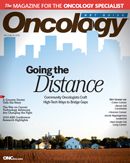Publication
Article
Oncology Live®
ASH 2010: Brentuximab Showing Promise as Hodgkin Lymphoma Therapy
Author(s):
An investigational drug known as brentuximab vedotin (SGN-35) achieved dramatic responses in a phase II study of younger patients with relapsed or refractory Hodgkin lymphoma (HL) who had no other treatment options
An investigational drug known as brentuximab vedotin (SGN-35) achieved dramatic responses in a phase II study of younger patients with relapsed or refractory Hodgkin lymphoma (HL) who had no other treatment options, investigators revealed at the 52nd American Society of Hematology Annual Meeting and Exposition. Based on results of this pivotal trial, Seattle Genetics and Millennium plan to seek regulatory approval of brentuximab in the United States and Europe as a treatment for HL and anaplastic large-cell lymphoma (ALCL). The companies expect to file in the first quarter of 2011.
In the single-arm study, three-quarters of patients demonstrated response (defined as >50% tumor shrinkage) and 34% achieved complete remission (CR). Overall, 94% of patients had some degree of tumor reduction, said Robert Chen, MD, assistant professor, Hematology and Hematopoietic Cell Transplantation at the City of Hope, Duarte, California.
“Up to 30% of all Hodgkin lymphoma patients will relapse. These patients have limited treatment options beyond autologous stem cell transplantation and represent a significant unmet medical need,” Chen told attendees at a press briefing. “Based on these data, brentuximab vedotin has the potential to change the treatment paradigm for relapsed or refractory Hodgkin lymphoma patients and could be the first treatment approved for these patients in more than 20 years.”
Brentuximab vedotin is an antibody-drug conjugate that uses an enzyme- cleavable linker to join SGN-30, a humanized anti-CD30 monoclonal antibody, with the cytotoxic monomethyl auristatin E (MMAE), a potent tubulin inhibitor. The drug targets tumor necrosis factor CD30 receptors; MMAE is not released until after the drug is taken into the tumor cells, which theoretically should spare non-CD30 cells from toxicity.
Investigators enrolled 102 patients with relapsed or refractory HL who had previously undergone autologous stem cell transplantation. Median age was 31 years (range, 15 to 77 years), and slightly more than half the patients (53%) were female. More than 70% had primary refractory disease, having failed to achieve CR or having progressed within 3 months of completing front-line therapy. In addition, 39% had disease that was refractory to the most recent salvage therapy (excluding autologous transplantation). Patients received a median of 4 prior treatment regimens (range, 1-13). The study’s primary endpoint was objective response rate (ORR) as assessed by independent central review.
All patients received 1.8 mg/kg of brentuximab vedotin every 3 weeks for ≤16 doses. Median duration of brentuximab vedotin treatment was 29 weeks (range, 3-54 weeks) by independent central review and 47 weeks by investigator assessment; the median number of cycles delivered was 9 (range, 1-16). Among patients achieving a CR, the median duration had still not been reached after a median follow- up of approximately 1 year.
Adverse effects were manageable; peripheral sensory neuropathy was the most common, followed by fatigue, nausea, upper respiratory tract infection, and diarrhea (Figure). The most common adverse events ≥grade 3 included neutropenia, peripheral sensory neuropathy, thrombocytopenia, and anemia.
In addition to the 75% ORR and 34% CR rate, 22% of patients had stable disease, 3% had progressive disease, and 1 patient was not evaluable for response. Progression-free survival (PFS) among all patients was 25 weeks according to independent review and 39 weeks based on investigator assessment. At the time of the meeting, PFS had not yet been reached in patients who achieved CR.
“Brentuximab vedotin achieves high response rates, has low toxicity, [and] allows patients to continue their daily routine. It has few side effects and many are reversible,” Chen said.
“This promising drug offers a new treatment option for patients with relapsed/refractory HL who have no other options,” stated Ginna Laport, MD, Stanford University School of Medicine, Stanford, California, who moderated the press conference where these data were released.










